Promising Nutritional Fruits Against Cardiovascular Diseases: An Overview of Experimental Evidence and Understanding Their Mechanisms of Action
- PMID: 34858028
- PMCID: PMC8631183
- DOI: 10.2147/VHRM.S328096
Promising Nutritional Fruits Against Cardiovascular Diseases: An Overview of Experimental Evidence and Understanding Their Mechanisms of Action
Abstract
Cardiovascular diseases (CVDs) are one of the leading causes of morbidity and mortality in both developed and developing countries, affecting millions of individuals each year. Despite the fact that successful therapeutic drugs for the management and treatment of CVDs are available on the market, nutritional fruits appear to offer the greatest benefits to the heart and have been proved to alleviate CVDs. Experimental studies have also demonstrated that nutritional fruits have potential protective effects against CVDs. The aim of the review was to provide a comprehensive summary of scientific evidence on the effect of 10 of the most commonly available nutritional fruits reported against CVDs and describe the associated mechanisms of action. Relevant literatures were searched and collected from several scientific databases including PubMed, ScienceDirect, Google Scholar and Scopus. In the context of CVDs, 10 commonly consumed nutritious fruits including apple, avocado, grapes, mango, orange, kiwi, pomegranate, papaya, pineapple, and watermelon were analysed and addressed. The cardioprotective mechanisms of the 10 nutritional fruits were also compiled and highlighted. Overall, the present review found that the nutritious fruits and their constituents have significant benefits for the management and treatment of CVDs such as myocardial infarction, hypertension, peripheral artery disease, coronary artery disease, cardiomyopathies, dyslipidemias, ischemic stroke, aortic aneurysm, atherosclerosis, cardiac hypertrophy and heart failure, diabetic cardiovascular complications, drug-induced cardiotoxicity and cardiomyopathy. Among the 10 nutritional fruits, pomegranate and grapes have been well explored, and the mechanisms of action are well documented against CVDs. All of the nutritional fruits mentioned are edible and readily accessible on the market. Consuming these fruits, which may contain varying amounts of active constituents depending on the food source and season, the development of nutritious fruits-based health supplements would be more realistic for consistent CVD protection.
Keywords: antioxidant; cardiovascular diseases; heart disease; hypertension; nutraceuticals; nutritional fruits.
© 2021 Zuraini et al.
Conflict of interest statement
The authors report no conflicts of interest in this work.
Figures




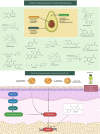
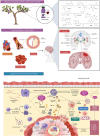
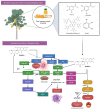
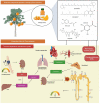

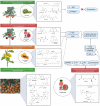
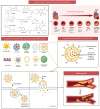
Similar articles
-
Fruits for Prevention and Treatment of Cardiovascular Diseases.Nutrients. 2017 Jun 13;9(6):598. doi: 10.3390/nu9060598. Nutrients. 2017. PMID: 28608832 Free PMC article. Review.
-
Prevention of Cardiovascular Diseases with Anti-Inflammatory and Anti- Oxidant Nutraceuticals and Herbal Products: An Overview of Pre-Clinical and Clinical Studies.Recent Pat Inflamm Allergy Drug Discov. 2018;12(2):145-157. doi: 10.2174/1872213X12666180815144803. Recent Pat Inflamm Allergy Drug Discov. 2018. PMID: 30109827 Review.
-
Bioactive Compounds (BACs): A Novel Approach to Treat and Prevent Cardiovascular Diseases.Curr Probl Cardiol. 2023 Jul;48(7):101664. doi: 10.1016/j.cpcardiol.2023.101664. Epub 2023 Feb 24. Curr Probl Cardiol. 2023. PMID: 36841315 Review.
-
Clinical Application of Melatonin in the Treatment of Cardiovascular Diseases: Current Evidence and New Insights into the Cardioprotective and Cardiotherapeutic Properties.Cardiovasc Drugs Ther. 2022 Feb;36(1):131-155. doi: 10.1007/s10557-020-07052-3. Epub 2020 Sep 14. Cardiovasc Drugs Ther. 2022. PMID: 32926271 Review.
-
Comparative Roles of IL-1, IL-6, IL-10, IL-17, IL-18, 1L-22, IL-33, and IL-37 in Various Cardiovascular Diseases With Potential Insights for Targeted Immunotherapy.Cureus. 2023 Jul 26;15(7):e42494. doi: 10.7759/cureus.42494. eCollection 2023 Jul. Cureus. 2023. PMID: 37637634 Free PMC article. Review.
Cited by
-
Modulation of Lipid Profile and Lipoprotein Subfractions in Overweight/Obese Women at Risk of Cardiovascular Diseases through the Consumption of Apple/Berry Juice.Antioxidants (Basel). 2022 Nov 14;11(11):2239. doi: 10.3390/antiox11112239. Antioxidants (Basel). 2022. PMID: 36421425 Free PMC article.
-
Bibliometric Analysis and Visualization of Scientific Literature on Heart Disease Classification Using a Logistic Regression Model.Cureus. 2024 Jun 27;16(6):e63337. doi: 10.7759/cureus.63337. eCollection 2024 Jun. Cureus. 2024. PMID: 39070375 Free PMC article. Review.
-
Pomegranate Wastes Are Rich in Bioactive Compounds with Potential Benefit on Human Health.Molecules. 2022 Aug 29;27(17):5555. doi: 10.3390/molecules27175555. Molecules. 2022. PMID: 36080321 Free PMC article.
-
Advanced Drug Delivery Micro- and Nanosystems for Cardiovascular Diseases.Molecules. 2022 Sep 9;27(18):5843. doi: 10.3390/molecules27185843. Molecules. 2022. PMID: 36144581 Free PMC article. Review.
-
Nutritional Composition, In Vitro Starch Digestibility and Antioxidant Activities of Composite Flour Made from Wheat and Mature, Unripe Pawpaw (Carica papaya) Fruit Flour.Nutrients. 2022 Nov 14;14(22):4821. doi: 10.3390/nu14224821. Nutrients. 2022. PMID: 36432508 Free PMC article.
References
-
- Weinhaus AJ, Roberts KP. Anatomy of the Human Heart. In: Iaizzo PA, editor. Handbook of Cardiac Anatomy, Physiology, and Devices: Second Edition. Totowa, NJ: Humana Press; 2005:59-85.
-
- Mesotten L, Maes A, Hambÿe A-S, et al. Nuclear cardiology, Part I: anatomy and function of the normal heart. J Nucl Med Technol. 1998;26(1):4–8. - PubMed
-
- Kadoya K, Kaneko S Modeling of a cardiovascular system to investigate factors affecting hypertension. 2018 12th International Symposium on Medical Information and Communication Technology (ISMICT): IEEE; 2018:1–6.
Publication types
MeSH terms
LinkOut - more resources
Full Text Sources
Medical

